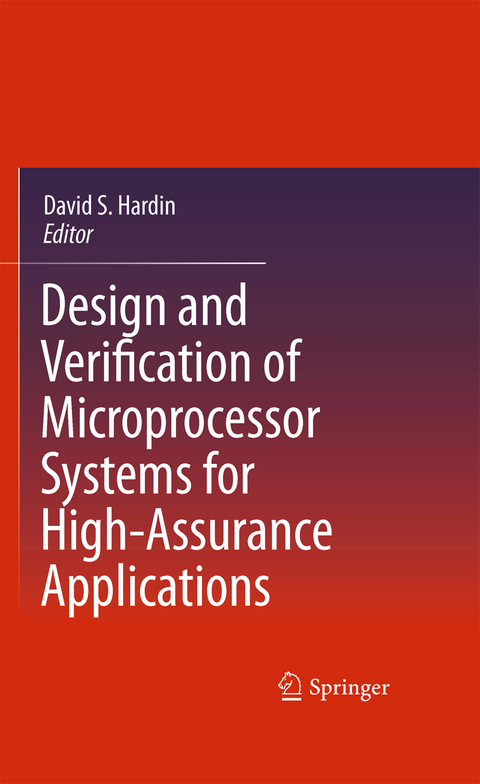
Design and Verification of Microprocessor Systems for High-Assurance Applications
Seiten
2014
Springer-Verlag New York Inc.
978-1-4899-8459-3 (ISBN)
Springer-Verlag New York Inc.
978-1-4899-8459-3 (ISBN)
This text examines several leading-edge design and verification technologies that have been successfully applied to microprocessor systems for high-assurance applications at various levels. It includes many practical case studies.
Microprocessors increasingly control and monitor our most critical systems, including automobiles, airliners, medical systems, transportation grids, and defense systems. The relentless march of semiconductor process technology has given engineers exponentially increasing transistor budgets at constant recurring cost. This has encouraged increased functional integration onto a single die, as well as increased architectural sophistication of the functional units themselves. Additionally, design cycle times are decreasing, thus putting increased schedule pressure on engineers. Not surprisingly, this environment has led to a number of uncaught design flaws. Traditional simulation-based design verification has not kept up with the scale or pace of modern microprocessor system design. Formal verification methods offer the promise of improved bug-finding capability, as well as the ability to establish functional correctness of a detailed design relative to a high-level specification. However, widespread use of formal methods has had to await breakthroughs in automated reasoning, integration with engineering design languages and processes, scalability, and usability.
This book presents several breakthrough design and verification techniques that allow these powerful formal methods to be employed in the real world of high-assurance microprocessor system design.
Microprocessors increasingly control and monitor our most critical systems, including automobiles, airliners, medical systems, transportation grids, and defense systems. The relentless march of semiconductor process technology has given engineers exponentially increasing transistor budgets at constant recurring cost. This has encouraged increased functional integration onto a single die, as well as increased architectural sophistication of the functional units themselves. Additionally, design cycle times are decreasing, thus putting increased schedule pressure on engineers. Not surprisingly, this environment has led to a number of uncaught design flaws. Traditional simulation-based design verification has not kept up with the scale or pace of modern microprocessor system design. Formal verification methods offer the promise of improved bug-finding capability, as well as the ability to establish functional correctness of a detailed design relative to a high-level specification. However, widespread use of formal methods has had to await breakthroughs in automated reasoning, integration with engineering design languages and processes, scalability, and usability.
This book presents several breakthrough design and verification techniques that allow these powerful formal methods to be employed in the real world of high-assurance microprocessor system design.
ACL2 and Its Applications to Digital System Verification.- A Mechanically Verified Commercial SRT Divider.- Use of Formal Verification at Centaur Technology.- Designing Tunable, Verifiable Cryptographic Hardware Using Cryptol.- Verifying Pipelines with BAT.- Formal Verification of Partition Management for the AAMP7G Microprocessor.- Compiling Higher Order Logic by Proof.- Specification and Verification of ARM Hardware and Software.- Information Security Modeling and Analysis.- Modeling and Security Analysis of a Commercial Real-Time Operating System Kernel.- Refinement in the Formal Verification of the seL4 Microkernel.- Specification and Checking of Software Contracts for Conditional Information Flow.- Model Checking Information Flow.
| Erscheint lt. Verlag | 28.11.2014 |
|---|---|
| Zusatzinfo | XIV, 436 p. |
| Verlagsort | New York |
| Sprache | englisch |
| Maße | 155 x 235 mm |
| Themenwelt | Informatik ► Weitere Themen ► CAD-Programme |
| Technik ► Bauwesen | |
| Technik ► Elektrotechnik / Energietechnik | |
| Technik ► Maschinenbau | |
| ISBN-10 | 1-4899-8459-3 / 1489984593 |
| ISBN-13 | 978-1-4899-8459-3 / 9781489984593 |
| Zustand | Neuware |
| Haben Sie eine Frage zum Produkt? |
Mehr entdecken
aus dem Bereich
aus dem Bereich
Buch | Softcover (2023)
Beuth (Verlag)
99,00 €
Einführung in die Geometrische Produktspezifikation
Buch | Softcover (2023)
Europa-Lehrmittel (Verlag)
20,70 €


